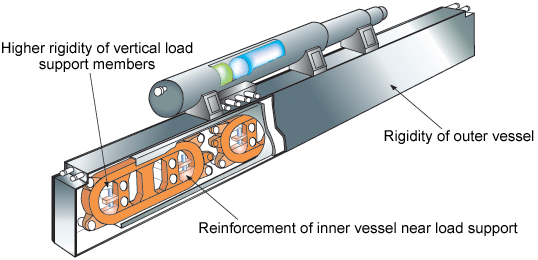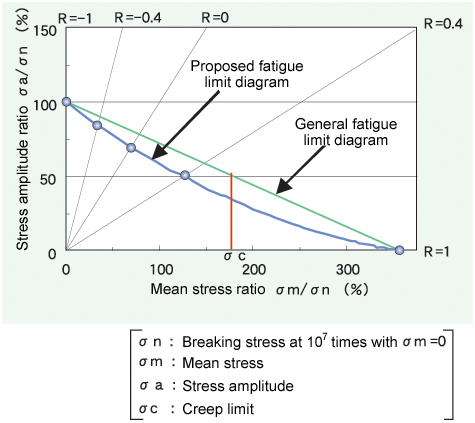2. Basic Technology Development
A ground coil attaching primary importance to reliability has been used on the Yamanashi Test Line on the assumption that the superconducting magnets at the time of construction will be used. However, under current development as basic technology in the Kunitachi Laboratories are a substantially simplified ground coil to reduce costs and a compliant highly vibration-resistant superconducting magnet. Research into the evaluation of the mechanical fatigue strength of ground coil resin is also underway.
(1) Development of a Superconducting Magnet for the Simplified Ground Coil System
Simplification of the ground coil system to be deployed on the guideway is under examination as a means of cost reduction, which is currently the biggest challenge in the technological development of the superconducting magnetically-levitated transportation system. For this purpose, the development of a superconducting magnet for the simplified ground coil system is required. The superconducting magnet must stay within the limit of the target weight, while demonstrating running vibration characteristics that satisfy the design standard vibration level and also ensuring that the heat in low temperature areas caused by vibration does not exceed the cooling capacity of the on-board refrigerator.
An electromagnetic vibration test on the superconducting magnet simulating the simplified ground coil system and a mechanical vibration test of the superconducting coil were carried out (Fig.6). The results showed increased fluctuating magnetic fields and fluctuating forces on the superconducting magnet, and the following measures to improve performance have been proposed in response to these tests:
(1) Reduce vibrations on the inner vessel and piping by improving the rigidity of the outer vessel.
(2) Remove the resonance frequency of the whole superconducting magnet from the running speed area by improving the rigidity of the vertical load support.
(3) Reduce heat generation due to vibration by making strain generated in the superconducting coil uniform through strengthening the inner vessel of the load support member.

Fig.6 Superconducting magnet for the simplified ground coil
The electromagnetic vibration test was conducted by improving the existing superconducting magnet as described above to verify these improvements. The test results verified that the preset requirements can be achieved. The performance improvement will be demonstrated in running tests on the Yamanashi Test Line.
(2) Evaluation of the Mechanical Fatigue Strength of Ground Coil Resin
Since the ground coil used in the superconducting magnetically levitated transportation system is an air-core coil without an iron core, the coil needs to be integrally molded with resin to keep the electromagnetic force acting repeatedly on the on-board superconducting magnet. The mold resin of the ground coil therefore requires, in addition to insulating material, the function of a mechanical strength member. In particular, high-insulation epoxy resin is chosen for the propulsion coil because it can be used in high-voltage environments.
However, the mechanical fatigue characteristics of polymer such as epoxy resin have not yet been sufficiently verified. Though the ground coil is used in a state in which both fluctuation stress and mean stress act simultaneously, only the results of fatigue strength tests with a mean stress where  have generally been compiled in the field of polymer. No fatigue limit diagram under the compound stress conditions required for designing a ground coil of this strength has previously been available. A new fatigue limit diagram of the epoxy resin for the propulsion coil on the Yamanashi Test Line was created based on repeated testing.
have generally been compiled in the field of polymer. No fatigue limit diagram under the compound stress conditions required for designing a ground coil of this strength has previously been available. A new fatigue limit diagram of the epoxy resin for the propulsion coil on the Yamanashi Test Line was created based on repeated testing.
The epoxy resin fatigue limit diagram describes a downward convex curve (Fig.7) and shows that the stress limit is revised downwards against the straight line that has been applied until now. This diagram enables the previously-impossible evaluation of fatigue strength under mean stress conditions, and the results obtained will be reflected in the ground coil design.

Fig.7 Epoxy resin fatigue limit diagram
HOME > Major Results of Research and Development in Fiscal 2003 > Superconducting Magnetically Levitated Transportation System

RTRI HOME
Copyright(c) 2004 Railway Technical Research Institute, Tokyo Japan, All rights reserved.


